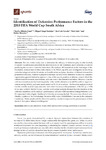Mostrar o rexistro simple do ítem
Identification of Defensive Performance Factors in the 2010 FIFA World Cup South Africa
| dc.contributor.author | Casal, Claudio Alberto | |
| dc.contributor.author | Andujar, Miguel Ángel | |
| dc.contributor.author | Losada, J.L. | |
| dc.contributor.author | Ardá Suárez, Antonio | |
| dc.contributor.author | Maneiro, Rubén | |
| dc.date | 2016 | |
| dc.date.accessioned | 2017-04-26T07:13:24Z | |
| dc.date.available | 2017-04-26T07:13:24Z | |
| dc.date.issued | 2016 | |
| dc.identifier.citation | Sports 2016, Vol. 4, Page 54 | es_ES |
| dc.identifier.issn | 2075-4663 | |
| dc.identifier.uri | http://hdl.handle.net/2183/18445 | |
| dc.description.abstract | The aim of this study was to determine the efficacy of defensive play in elite football, to identify variables associated with the direct recovery of ball possession, and to propose a model for predicting the success of defensive transitions. We analyzed 804 transitions in the final stages of the Fedération Internationale Football Association (FIFA) World Cup 2010, and investigated the following variables using univariate, bivariate, and multivariate analyses: duration of defensive transition, possession loss zone, position of players at the start and end of the defensive transitions, defensive organization, general defensive approach, time of the match, position of defense, zone in which the offensive transition ends, match status, and outcome of the defensive transition. We found that the defensive transitions started most frequently in the middle offensive zone (48.9%), with an organized defense set-up (98.8%), and were unsuccessful on 57.2% of occasions. The bivariate analysis showed that the variable most strongly associated with direct recovery of the possession of the ball (p = 0.018) is the area in which the ball is lost, and the multivariate analysis showed that the duration of the defensive transition can be used as a performance indicator, with transitions lasting between 0 and 15 s associated with a higher likelihood of directly recovering the ball. This work has allowed us to identify a pattern of tactical-strategic behavior with major probabilities of success in the defensive transitions. These results will be able to be used by coaches to improve the performance of their teams in this type of situation in the game. | es_ES |
| dc.description.sponsorship | Ministerio de Economía y Competitividad; PSI2015-71947-REDT | es_ES |
| dc.description.sponsorship | Ministerio de Economía y Competitividad; DEP2015-66069-P | es_ES |
| dc.description.sponsorship | Cataluña. Generalitat; 2014 SGR 971 | es_ES |
| dc.language.iso | eng | es_ES |
| dc.publisher | Multidisciplinary Digital Publishing Institute | es_ES |
| dc.relation.uri | http://dx.doi.org/10.3390/sports4040054 | es_ES |
| dc.rights | Reconocimiento 3.0 | es_ES |
| dc.rights.uri | http://creativecommons.org/licenses/by/3.0/ | |
| dc.subject | Elite soccer | es_ES |
| dc.subject | Defensive phase | es_ES |
| dc.subject | Observational methodology | es_ES |
| dc.subject | Performance analysis | es_ES |
| dc.title | Identification of Defensive Performance Factors in the 2010 FIFA World Cup South Africa | es_ES |
| dc.type | info:eu-repo/semantics/article | es_ES |
| dc.rights.access | info:eu-repo/semantics/openAccess | es_ES |
| UDC.journalTitle | Sports | es_ES |
| UDC.volume | 4 | es_ES |
| UDC.issue | 4 | es_ES |
| UDC.startPage | 54 | es_ES |
Ficheiros no ítem
Este ítem aparece na(s) seguinte(s) colección(s)
-
GI-PHG - Artigos [101]






